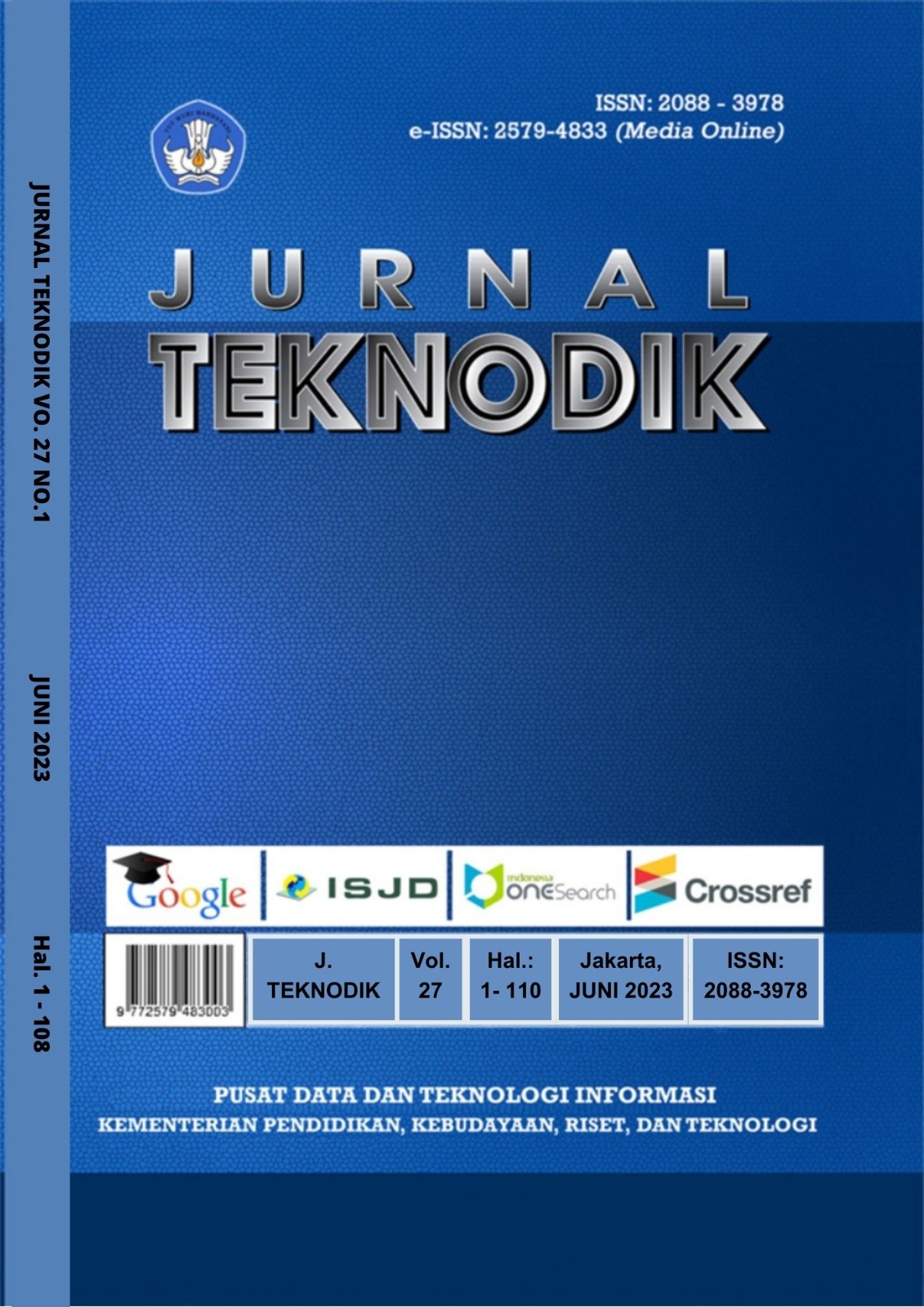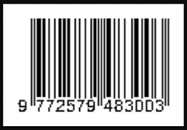Model Diklat Daring Guru Kejuruan Pada Mata Diklat Perencanaan Jaringan Komputer Di Bbppmpv Boe Malang
Online Training Model for Vocational Teachers on the Subject of Computer Network Planning at BBPPMPV BOE Malang
DOI:
https://doi.org/10.32550/teknodik.vi.883Keywords:
model pembelajaran daring, live session, pandemic covid -19, guru kejuruanAbstract
Tujuan dari penelitian ini adalah untuk mengetahui model dan pola pembelajaran yang dapat diterapkan pada masa pandemi covid-19. Pandemi virus corona (Covid -19) saat ini sedang melanda seluruh penjuru dunia, termasuk di Indonesia. Dengan adanya Covid -19 ini, maka telah mengubah strategi dan model pembelajaran, baik pada preservice training maupun inservice training. Karena kebijakan pemerintah yang melarang pembelajaran tatap muka selama pandemi covid-19, perlu dicarikan alternatif pembelajaran lain yang tidak mempertemukan secara fisik pada dimensi ruangan dan waktu yang sama. Salah satu model yang diterapkan oleh Balai Besar Pengembangan Penjaminan Mutu Pendidikan Vokasi Bidang Otomotif dan Elektronika Malang (BBPPMPV BOE Malang) adalah pelaksanaan diklat pada mata diklat Perencanaan Jaringan Komputer dengan model daring. Penelitian ini menggunakan metode R&D. Dalam pengembangannya, diklat ini menggunakan ADDIE model, yang terdiri dari Analysis, Design, Development, Implementation, dan Evaluation. Berdasarkan dari hasil kajian pustaka, penerapan model, dan pengamatan di lapangan, diperoleh model pembelajaran daring penuh dengan pola 45 JP yang terdiri dari materi umum (3 JP), materi pokok (40JP), dan materi penunjang (2 JP). Materi tersebut disampaikan secara online. Sementara itu, untuk menghadirkan kelas praktik kepada peserta diklat daring guru kejuruan secara sinkronous dan real time, digunakan kegiatan Live Session (LS) sebanyak 4 kali dalam 1 diklat daring. Model ini cocok diterapkan sebagai salah satu alternatif pembelajaran daring guru kejuruan terutama di era pandemi.
The objective of this study is to discover learning models and patterns that could be applied during the COVID-19 pandemic era. The coronavirus pandemic (Covid -19) is currently sweeping all over the world, including Indonesia. The existence of Covid -19 has been changing the learning strategies and models, both in preservice training and in-service training. Vecause the government forbids face-to-face learning to take place during the Covid-19 pandemic era, alternative learning that doesn’t apply face-to-face learning in the same space and time dimension should be made. One of the models applied by the Balai Besar Pengembangan Penjaminan Mutu Pendidikan Vokasi Bidang Otomotif dan Elektronika (BBPPMPV BOE) Malang is the implementation of online training on the Subject of Computer Network Planning. This Research is conducted based on the R & D method with ADDIE stepping i.e. Analysis, Design, Development, Implementation, and Evaluation. Based on the results of the literature review, application of models, and field observations, a full online learning model is obtained with 45 LH pattern consisting of general material (3 LH), subject matter (40 LH), and supporting material (2 LH). The material is delivered online. Meanwhile, to present online practical classes to vocational teachers synchronously and in real-time, 4 Live Sessions (LS) are applied in a single training. This model is suitable to apply as an alternative for vocational teacher training, especially during the pandemic era.
References
Anderson, L.W. (Ed.), Krathwohl, D.R. (Ed.), Airasian,P.W., Cruikshank, K.A., Mayer, R.E., Pintrich, P.R., Raths, J., & Wittrock, M.C. (2001). A taxonomy for learning, teaching, and assessing: A revision of Bloom’s Taxonomy of Educational Objectives (Complete edition). New York: Longman.
Arends, R.I. (2012). Learning to Teach (9th Ed). New York : McGraw - Hill Higher Education.
Bersin, J. (2004). The Blended Learning Book: Best Practice,
Proven Methodologies and Lessons Learned. New York: John Wiley & Sons Inc.
Branch, R.M, “Instructional Design : ADDIE approachâ€, Springer, 2009
Bruner, J. (1996). Toward a Theory of Instruction. Cambridge, MA: Harvard University Press.
Chaeruman, U.A., (2020), Ruang Belajar Baru dan Implikasi Terhadap Pembelajaran di Era Tatanan Baru, Jurnal Kwangsan Vol: 08/01 Juli 2020. http://dx.doi.org/1031800/jtp. kw.v6n1.p141-153.
Chang S. and Smith R. (2008). Effectiveness of personal interaction in a learner-centered paradigm distance education class based on student satisfaction. Journal of Research on Technology in Education, 40(4), 407-426.
Cheung, W. S. & Hew, K. F. (2011). Design and evaluation of two blended learning approaches: Lessons learned. In Hong, K. S. & Lai, K. W. (Eds), ICT for accessible, effective and efficient higher education: Experiences of Southeast Asia.Australasian Journal of Educational Technology, Vol 27, No.8, pp.13191337.
Chung, M.K. (2002). The Development of Self Regulated Learning. Journal of The Institut of Asia Pasific Education Development, 1 (1), 55 – 56.
Dabbagh and Ritland, Online Learning: Concepts, Strategies, and Application. Education Tech
Research Dev 55, 667–669 (2007). https://doi.org/10.1007/s11423-007-9071-4
Degeng I.N.S. (2013). Ilmu Pembelajaran Klasifikasi Variabel Untuk Pengembangan Teori dan Penelitian. Bandung : Arasmedia.
Dunlap, J. C. & Gabringer, R. S. (1996). Rich environments for active learning in the higher education. In B.G. Wilson (Ed.), Constructivist Learning Environments: Case studies in Instructional Design (pp. 151-174). New Jersey: Educational Technology Publications.
Downes, S. (2010). New Technology Supporting Informal Learning. Journal of Emerging Technologies in Web Intelligence, 2(1), 27-33.
Dziuban, C. D., Hartman, J., Juge, F., Moskal, P. D. (2004). Blended Learning ECAR Research Bulletin. Retreived from http://www.educase.edu/ecar.
Dziuban, C. D., Hartman, J., Juge, F., Moskal, P. D., and Sorg, S. (2006). Blended learning enters the mainstream. In The Hand-book of Blended Learning: Global Perspectives, Local Designs , edited by C. J. Bonk and C. R. Graham, pp. 195–208. San Francisco, CA: Pfeiffer Publishing.
Gagne, E.D. (1985). The Conditions of Learning and Theory of Instruction, Fourth Editions. New York: Holt, Rinehart & Winston.
Gardner , H. (1999). The Discipline Mind: What All Student Should Understanding. New York: Simon&Schuster Inc.
Graham CR. (2006). Blended Learning Systems : Definition, Current Trends and Future Directions, dalam C. Bonk and C. Graham (Eds), The Hand Book of Blended Learning, Global Perspectives Local Design. San Francisco : John Wiley & Sons, Inc., pp 3 -19.
Graham, C. R., Allen, S., and Ure, D. (2004). Blended Learning Environments: A Review of the Research Literature, http://msed.byu.edu/ipt/graham/vita/ ble_litrev.pdf.
Graham, C. R., Allen, S., and Ure, D. (2003). Blended Learning Environments: A Review of the Research Literature, Retreived http://msed.byu.edu/ipt/graham/vita/ ble_litrev.pdf.
Harding, A., Kaczynski, D. & Wood, L.. (2005). Evaluation of Blended Learning: Analysys of Qualitative Data, Proceedings of the Universe Science Blended Learning Symposium, Sydney: The University of Sydney.
Kemdikbud, (2016). Buku Manual Untuk Pengampu dan Mentor, Guru Pembelajar Moda Daring. Jakarta: Kemendikbud.
Kramarski, B. & Mizrachi, N. (2006). Online Discussion and Self regulated Learning: Effect of Instructional Methods on Mathematical Literacy. The Journal of Educational Research. 99 (4), 218-230.
Love, A. and Kruger A.C. (2005). Teacher Beliefs and Student Achievement in Urban Schools Serving African American Students.
The Journal of Education Research. 99 (2), 87 – 98.
Ma, L. 2010. Knowing and Teaching Elementary Mathematics Teachers' Understanding of Fundamental Mathematics in China and the United States. New York: Routledge.
Miller, M. D. (2014). Minds online: Teaching effectively with technology. Harvard University Press. Muraina, I. O., Okedeyi.
Montalvo, F.T. & Torres, M.C. (2004). Self Regulated Learning: Current nd Future Directions. Spain: Department of Education University de Navarra. Electronic Journal of Research in Educational Psychology, 2 (1), 3-27.
Morisson. D. (2003)., E-Learning Strategies, How to Get Implementation and Delivery Right First Time, England: John Willy & Sons.
Osguthorpe, R. T. and Graham, C. R. (2003). Blended Learning Systems: Definitions and Directions. Journal of Distance Education., 4(3), 227–234.
Orhan, F. (2007). Applying Self Regulated Learning Strategies In Blended Learning Instruction. World Applied Sciences Journal, 2(4) 390-398.
Paurelle, S. (2003). E - Learning and Constructivism. Informally published manuscript, Learning & Teaching Enhancement Unit, Canterbury Christ Church University College, Canterbury, United Kingdom. Retrieved from http://www. canterbury.ac.uk/Support/learning -teaching – enhancement - unit/Resources/Docu-ments/BriefingNotes/ ConstructivistPedagogy.pdf
Paris, S.G. (2001). Classroom Applications of Research on Self Regulated Learning. Educational Psychologist Journal, 36, 89-91.
Rasheed, R. A., Kamsin, A., & Abdullah, N. A. (2020). Challenges in the online component of blended learning: A systematic review. Computers & Education, 144, 103701. https://doi.org/10.1016/j.compedu.2 019.103701
Reigeluth, C.M. (Eds) (1999). Instructional-Design Theories and Models: A New paradigm of Instructional Theory. Vol II. Mahwah, NJ: Lawrence Erlbaum Associates.
Schifter, C., & Cipollone, M. (2013). Minecraft as a teaching tool: One case study. In Society for Information Technology & Teacher Education International Conference (Vol. 2013, No. 1, pp. 2951 - 2955). Retrieved from http://www.editlib.org /p/48540/proceeding_ 48540.pdf
Setyosari, P. (2015). Metode Penelitian Pendidikan dan Pengembangan. Jakarta: Kencana / Prenandamedia Group
Siemens, G. (2005). Connectivism: A learning theory for the digital age. International Journal of Instructional Technology and Distance Learning, 2 (1), 3-10.
Siyamta (2018), Pengaruh Strategi Pembelajaran dan Self Regulated Learning Terhadap Kemampuan Menerapkan Konsep Mengadminis-trasi Sistem Operasi Jaringan Komputer Pada Guru SMK, Universitas Negeri Malang : Disertasi Program Doktor Teknologi Pembelajaran.
Siyamta, Setyosari,. P, Waras, Ulfa, S. (2016). A Comparasion of Two Massive Open Online Course in Teaching and Learning, Educational Technology World Conference (ETWC). Denpasar, Bali. International Proceedings ISBN 978 602 747 233 4
Siyamta, Setyosari., P, Waras, Ulfa. S. (2016). Developing Digital Content of “Guru Pembelajar†Using Learning Management System (LMS) Moodle and Technological Pedagogical Content Knowledge (TPACK) Framework, International Seminar at University of Surabaya (UNESA). International Proceedings ISBN 978602 601590 7
Slavin, R. E. (2008). Educational Psychology Theory and Practice (9th). New York: Pearson Inc.
Voos, R. (2003). Blended Learning – Whats is and Where Might it take Us? Sloan-C View (2)1. Retrieved from http://aln.org/publi-cations/view/v2n1/blended.htm.
Zhang, W., Wang, Y., Yang, L., & Wang, C. (2020). Suspending Classes Without Stopping Learning: China’s Education Emergency Management Policy in the COVID-19 Outbreak. Journal of Risk and Financial Management, 13(3), 55. https://doi.org/10.3390/ jrfm13030055
Zimmerman, B. J. (2004). Sociocultural influence and students’ development of academic self-regulation: A social-cognitive perspective. In D. M. McInerney & S. Van Etten (Eds.), Big Theories Revisted (pp.139-164). Greenwhich, CT: Information Age.
Zumbrunn S et.al. (2011), Encouraging Self-Regulated Learning in the Classroom: A Review of the Literature, Metropolitan Educational Research Consortium (MERC), Virginia Commonwealth University.
Downloads
Published
How to Cite
Issue
Section
Citation Check
License
Copyright (c) 2023 Jurnal Teknodik

This work is licensed under a Creative Commons Attribution-NonCommercial-ShareAlike 4.0 International License.
Please download and complete the Form, Copyright Transfer, and Ethics Statement Form. The following is provided at the time of submitting the text (Upload Additional Files):










